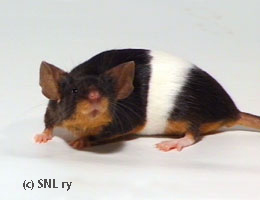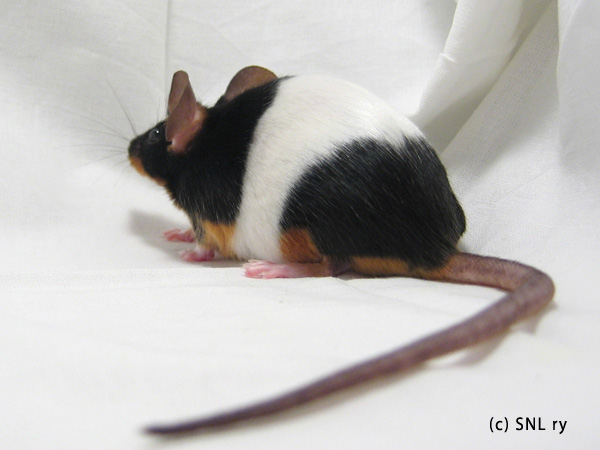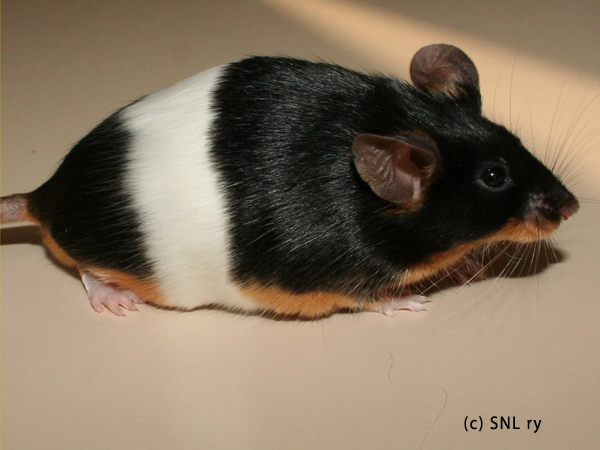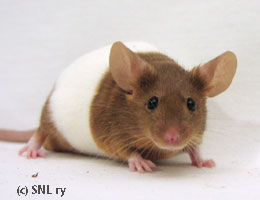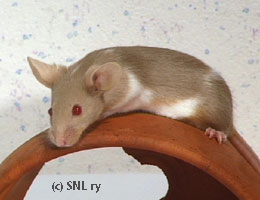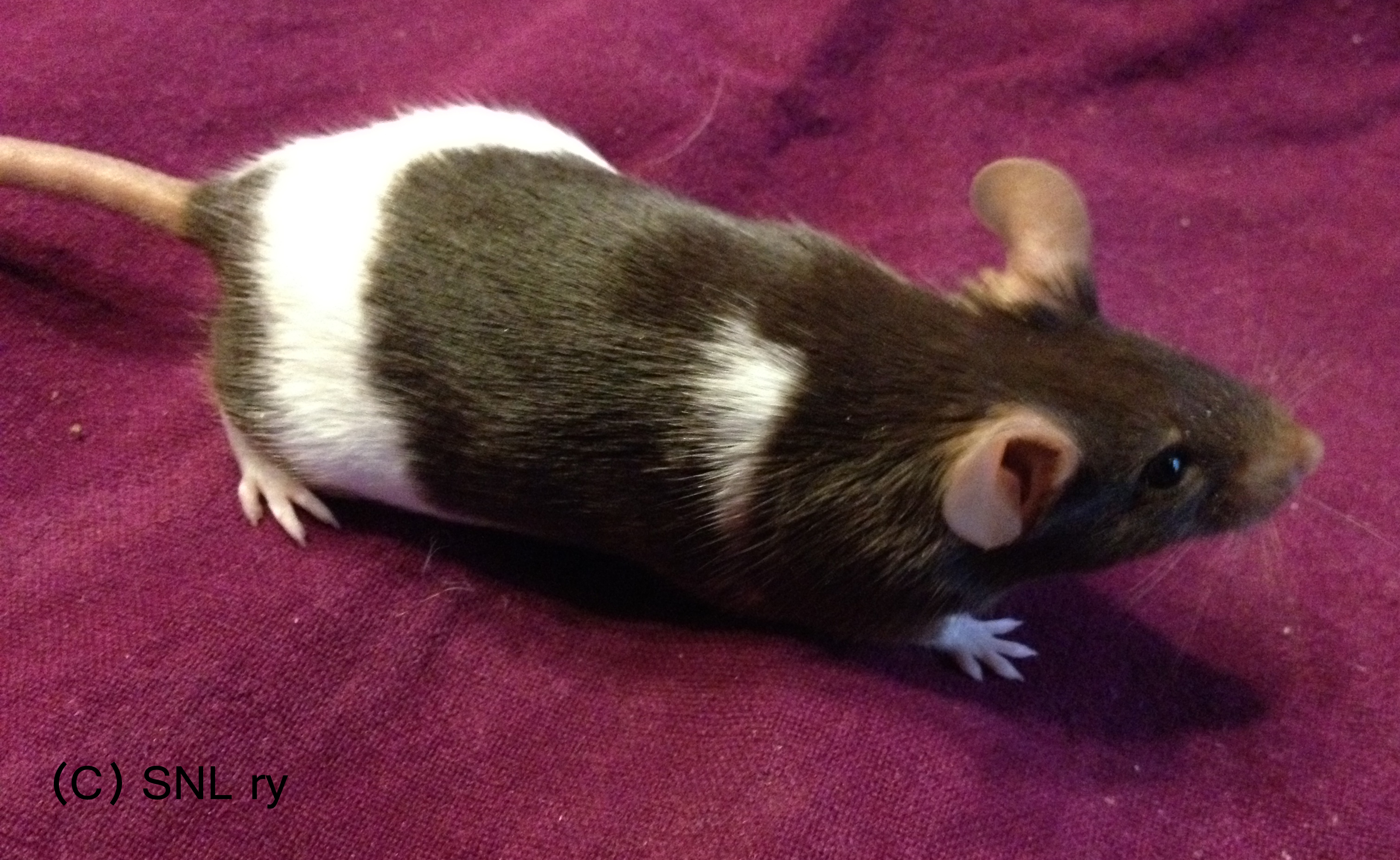Varieties
Marked
Banded (*/b)
Wsh/+
"Eyes as with the standardized color. A mouse of any recognized standard colour, with a white zone encircling the body and 1/4 of the length of the body, positioned at the third quarter of the body length from the head, excluding the tail. Sharpness of demarcation to be of prime importance. Feet white."
Breeding information below the pictures.
Quick Look
Banded is one of my favourite varieties. Itd first appeared in a laboratory late 1970's as a spontaneous mutation when crossing two inbred strains of mice together. It was introduced to the mouse fancy in 1978. Being dominant banded isn't quite hard to breed for example into new colors, but it is hard to breed the exact markings required by the standard.
Genetic Background
Genetically speaking, banded is a spontaneous mutation in the w-locus. More precisely, banded is made by a gene called "sash": Wsh. The genetic code is Wsh/+, the plus mark tells you that the other gene present is the wild type gene, the unmutated "original".
Banded can be bred with another w-locus mutation, a gene called "banded", Wbd, banded markings being born with Wsh/+. These can't that much be told apart from sash-made bandeds, until litters start turning up Wbd/Wbd that turn anaemic and die.
Wsh is a semidominant and like the whole of w-locus, is located in chromosome 5. Via linkage, this affect what else the mouse can be besides banded. Other qualities reciding in the same choromosome are either linked with Wbd, or can be introduced only through re-linkage.
Before the appearance of Wsh , there was already a variety called banded, made by a recessive gene called "belted". Belted made a quite narrow band. This gene hasn't really been seen in ages, but who's to tell it stays that way. Odder things have happened than a re-emergence of a forgotten gene! However, belted isn't dealt with here.
Never, under any circumstance, cross bandeds (neither Wsh nor Wbd ) with any other w-locus mutation. For example Wsh /Wv (that is, sash/viable dominant white spotting) gives you either or completely white mouse, or a mouse with colour only on ears. (Of course, you might want to breed mice looking just like that.)
In More Practical Terms...
Banded is said to be dominant. More precisely, the gene (genes, as both sash and banded work the same way) is a semidominant. That is, the phenotype is affected by both alleles present.
Combinations:
Wsh/+ x (on w-locus) +/+, banded x non-banded = both banded and non-banded.
Wsh /+ x Wsh /+, banded x banded = banded, non-banded and "charlies". Charlies are genetically double-bandeds (Wsh /Wsh ), with colouring only on head and rump. An interesting tidbit nicked from lab info: the resistance towards ecttoparasites in Wsh /Wsh mice are weakened already with second infection!
Wsh /Wsh x +/+, charlie x non-banded = in theory a whole litter of bandeds. "In theory", as some mice can be so lightly marked you can't really spot the markings at all: only a couple of light hairs where the band should be. Mistaking one of these as non-marked and mating it to a non-banded mouse can cause surprises, I can tell you!
Banded mice from a banded to banded mating have usually great differences in the width of the band and they may have a few belly spots (= coloured spots on the white band, a difficult to eradicate fault). Banded mated to banded-related self (= non-patterned) produces more even bands and fewer belly spots. Banded mated to a non-banded related self (are you still following me?) produces wider bands, but the demarcation lines can be rather ragged.
Again: never mix any other markings with bandeds! The one exception is capped, which has proved to work rather well with banded.
The white zone should be straight and clean cut, which is of prime importance when breeding banded. Of course, colour, size and type should never be forgotten! Banded mice with head spots shouldn't be used for future breeding, as it isn't wise to get any unnecessary white spotting genes in the bandeds. The tail should be all coloured and feet white, mice with the best front foot coloring often tend to have white tail tips.
It's best to try and breed with the straightest patterned mice, if possible. Also make sure that both parents do not share their faults! Some bandeds have coloured spots in the belly, which are better left out of breeding programme unless the animal is otherwise outstanding. These spots are notoriously difficult to breed out, especially those spots that appear only as the mouse ages.
The feet markings should be as follows: the front feet should be white and the back feet white from the tips of the toes to the middle of the feet.
Starting From Scratch?
No bandeds around? Try to find a charlie, hope that it truly is a double-banded (and not a recessive white spotting s/s mouse) and mate with a suitable partner. If there aren't any bandeds or charliers (or cappeds) anywhere, you simply can not make a banded.

